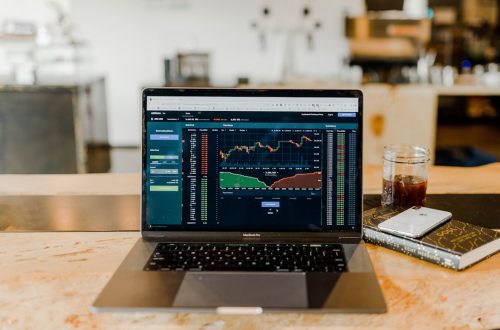The stock market is a complex and dynamic system where shares of publicly traded companies are bought and sold. It is a marketplace where investors can buy ownership in a company, and in return, the company receives capital to grow and expand its business. The stock market is also a platform for investors to trade securities, which are essentially financial assets such as stocks, bonds, and derivatives. Understanding the stock market involves grasping the concepts of supply and demand, market trends, and the factors that influence stock prices. It is important to recognize that the stock market can be volatile and unpredictable, and that investing in stocks carries inherent risks.
Furthermore, understanding the stock market also involves familiarizing oneself with the different stock exchanges where securities are traded. In the United States, the major stock exchanges include the New York Stock Exchange (NYSE) and the Nasdaq. Each exchange has its own listing requirements and trading hours, and they play a crucial role in facilitating the buying and selling of stocks. Additionally, it is essential to comprehend the various investment vehicles available in the stock market, such as mutual funds, exchange-traded funds (ETFs), and individual stocks. Each investment vehicle has its own unique characteristics and level of risk, and understanding these differences is vital for making informed investment decisions.
Key Takeaways
- Understanding the Stock Market:
- The stock market is a platform for buying and selling shares of publicly traded companies.
- It is influenced by various factors such as economic indicators, company performance, and market sentiment.
- Setting Up a Trading Account:
- Choose a reputable brokerage firm to open a trading account.
- Consider factors such as fees, customer service, and available trading tools when selecting a brokerage.
- Choosing the Right Stocks to Trade:
- Research and analyze different stocks to identify potential trading opportunities.
- Consider factors such as company financials, industry trends, and market volatility when selecting stocks.
- Developing a Trading Strategy:
- Create a trading plan that outlines your goals, risk tolerance, and entry/exit criteria.
- Test your strategy using a demo account before implementing it with real money.
- Managing Risk and Setting Stop Losses:
- Use stop losses to limit potential losses and protect your trading capital.
- Consider position sizing and diversification to manage risk effectively.
- Monitoring and Analyzing Your Trades:
- Keep track of your trades and analyze their performance to identify strengths and weaknesses.
- Use trading journals and performance metrics to evaluate your trading strategy.
- Learning from Your Mistakes and Refining Your Approach:
- Reflect on your trading mistakes and learn from them to improve your approach.
- Continuously refine and adapt your trading strategy based on your experiences.
Setting Up a Trading Account
Setting up a trading account is the first step towards participating in the stock market. A trading account is a specialized brokerage account that allows investors to buy and sell securities. When setting up a trading account, it is important to choose a reputable and reliable brokerage firm that offers the services and features that align with your investment goals. There are various types of brokerage accounts available, including cash accounts, margin accounts, and retirement accounts, each with its own set of rules and regulations.
Once you have selected a brokerage firm, you will need to complete an application process to open a trading account. This typically involves providing personal information, such as your name, address, social security number, and employment details. Additionally, you may be required to fund your trading account by depositing an initial amount of money. This initial deposit will serve as your trading capital, which you can use to purchase securities in the stock market. After your trading account is set up and funded, you will have access to a trading platform where you can execute buy and sell orders for stocks and other securities.
Choosing the Right Stocks to Trade
Choosing the right stocks to trade is a critical aspect of successful investing in the stock market. There are thousands of publicly traded companies to choose from, each with its own unique financial performance, industry sector, and growth potential. When selecting stocks to trade, it is important to conduct thorough research and analysis to identify companies that align with your investment objectives. This may involve evaluating a company’s financial statements, analyzing its competitive position in the market, and assessing its future growth prospects.
Furthermore, it is essential to consider the broader economic and market conditions when choosing stocks to trade. Economic indicators, such as GDP growth, inflation rates, and interest rates, can have a significant impact on stock prices. Additionally, market trends and investor sentiment can influence the performance of individual stocks and industry sectors. By staying informed about macroeconomic trends and market dynamics, you can make more informed decisions when selecting stocks to trade.
In addition to fundamental analysis, technical analysis can also be used to identify potential trading opportunities. Technical analysis involves studying historical price charts and using various technical indicators to forecast future price movements. By analyzing price patterns and market trends, traders can identify entry and exit points for their trades. Ultimately, choosing the right stocks to trade requires a combination of fundamental research, market analysis, and technical expertise.
Developing a Trading Strategy
| Metrics | Value |
|---|---|
| Winning Trades | 70% |
| Average Return | 5% |
| Maximum Drawdown | 10% |
| Sharpe Ratio | 1.5 |
Developing a trading strategy is essential for achieving success in the stock market. A trading strategy outlines a set of rules and guidelines for making investment decisions and managing trades. It helps traders to stay disciplined and focused on their long-term goals, while also providing a framework for risk management and trade execution. There are various trading strategies that traders can adopt, depending on their risk tolerance, investment horizon, and market expertise.
One common trading strategy is trend following, which involves identifying and capitalizing on market trends. Trend followers aim to ride the momentum of a stock or market trend by buying when prices are rising and selling when prices are falling. Another popular strategy is mean reversion, which involves betting that prices will revert back to their historical average after experiencing a temporary deviation. Mean reversion traders look for overbought or oversold conditions in the market and take positions based on the expectation of a price reversal.
In addition to trend following and mean reversion strategies, there are also event-driven strategies that focus on specific catalysts or events that can impact stock prices. For example, traders may look for opportunities around earnings announcements, mergers and acquisitions, or regulatory changes that can create volatility in the market. By developing a trading strategy that aligns with your investment style and risk tolerance, you can increase your chances of success in the stock market.
Managing Risk and Setting Stop Losses
Managing risk is a crucial aspect of trading in the stock market. While investing in stocks can be rewarding, it also carries inherent risks that can lead to financial losses. Therefore, it is important for traders to implement risk management techniques to protect their capital and minimize potential losses. One common risk management tool used by traders is setting stop losses. A stop loss is an order placed with a broker to sell a security when it reaches a certain price level. By setting stop losses, traders can limit their downside risk and protect themselves from significant losses in the event of adverse price movements.
In addition to setting stop losses, traders can also manage risk by diversifying their portfolios across different asset classes and industry sectors. Diversification helps to spread risk across multiple investments, reducing the impact of any single investment on the overall portfolio. Furthermore, traders can use position sizing techniques to control the amount of capital allocated to each trade relative to their total portfolio size. By managing position sizes based on risk tolerance and portfolio objectives, traders can avoid overexposure to any single trade or asset class.
Moreover, risk management also involves staying disciplined and adhering to your trading strategy. Emotions such as fear and greed can cloud judgment and lead to impulsive decision-making, which can increase the likelihood of incurring losses. By maintaining discipline and following a well-defined trading plan, traders can mitigate emotional biases and make more rational investment decisions.
Monitoring and Analyzing Your Trades

Monitoring and analyzing your trades is essential for evaluating your performance as a trader and identifying areas for improvement. By keeping track of your trades and analyzing their outcomes, you can gain valuable insights into your strengths and weaknesses as an investor. This process involves reviewing your trade history, analyzing your entry and exit points, and assessing the overall profitability of your trades.
Furthermore, monitoring your trades also involves staying informed about market developments and news that can impact your investments. By staying abreast of economic indicators, corporate earnings reports, and geopolitical events, you can make more informed decisions about your trades. Additionally, it is important to analyze the performance of individual stocks and industry sectors to identify trends and patterns that can inform future investment decisions.
In addition to monitoring your trades, it is also important to keep detailed records of your trading activities. This includes maintaining a trading journal that documents your trade rationale, entry and exit points, position sizes, and overall performance. By keeping a trading journal, you can track your progress over time and identify areas for improvement in your trading approach.
Learning from Your Mistakes and Refining Your Approach
Learning from your mistakes is an integral part of becoming a successful trader in the stock market. Every trader will inevitably make mistakes at some point in their career, but what sets successful traders apart is their ability to learn from those mistakes and refine their approach. By reflecting on past trades and identifying areas for improvement, traders can adapt their strategies and become more effective investors.
One way to learn from mistakes is to conduct post-trade analysis after each trade. This involves reviewing the outcome of the trade, identifying any errors or misjudgments that were made, and determining how those mistakes can be avoided in the future. By learning from past mistakes, traders can refine their approach and make better decisions in subsequent trades.
Moreover, seeking feedback from experienced traders or mentors can also provide valuable insights into areas for improvement. By learning from the experiences of others who have navigated the challenges of the stock market, traders can gain new perspectives and refine their approach to investing.
In conclusion, becoming a successful trader in the stock market requires a combination of knowledge, discipline, and continuous improvement. By understanding the intricacies of the stock market, setting up a trading account with a reputable brokerage firm, choosing the right stocks to trade through thorough research and analysis, developing a sound trading strategy that aligns with your investment goals, managing risk through setting stop losses and diversification techniques, monitoring and analyzing your trades for performance evaluation purposes while learning from mistakes made along the way; traders can increase their chances of success in the dynamic world of stock trading.
FAQs
What is stock trading?
Stock trading is the buying and selling of shares of publicly traded companies on a stock exchange. It allows individuals and investors to participate in the ownership of companies and potentially profit from the company’s success.
How do I start trading stocks?
To start trading stocks, you will need to open a brokerage account, research and choose the stocks you want to invest in, and place buy and sell orders through your chosen brokerage platform.
What do I need to consider before starting to trade stocks?
Before starting to trade stocks, it’s important to consider your investment goals, risk tolerance, and the amount of capital you are willing to invest. It’s also important to educate yourself about the stock market and understand the potential risks and rewards of stock trading.
What are the different types of stock orders?
There are several types of stock orders, including market orders, limit orders, stop orders, and stop-limit orders. Each type of order has its own specific instructions for executing a trade at a certain price or under certain conditions.
What are some common stock trading strategies?
Some common stock trading strategies include day trading, swing trading, value investing, and growth investing. Each strategy involves different approaches to buying and selling stocks based on market conditions and investment goals.
What are the risks of trading stocks?
Trading stocks involves risks such as market volatility, company-specific risks, and the potential for financial loss. It’s important for investors to carefully consider these risks and to diversify their investment portfolio to mitigate potential losses.


